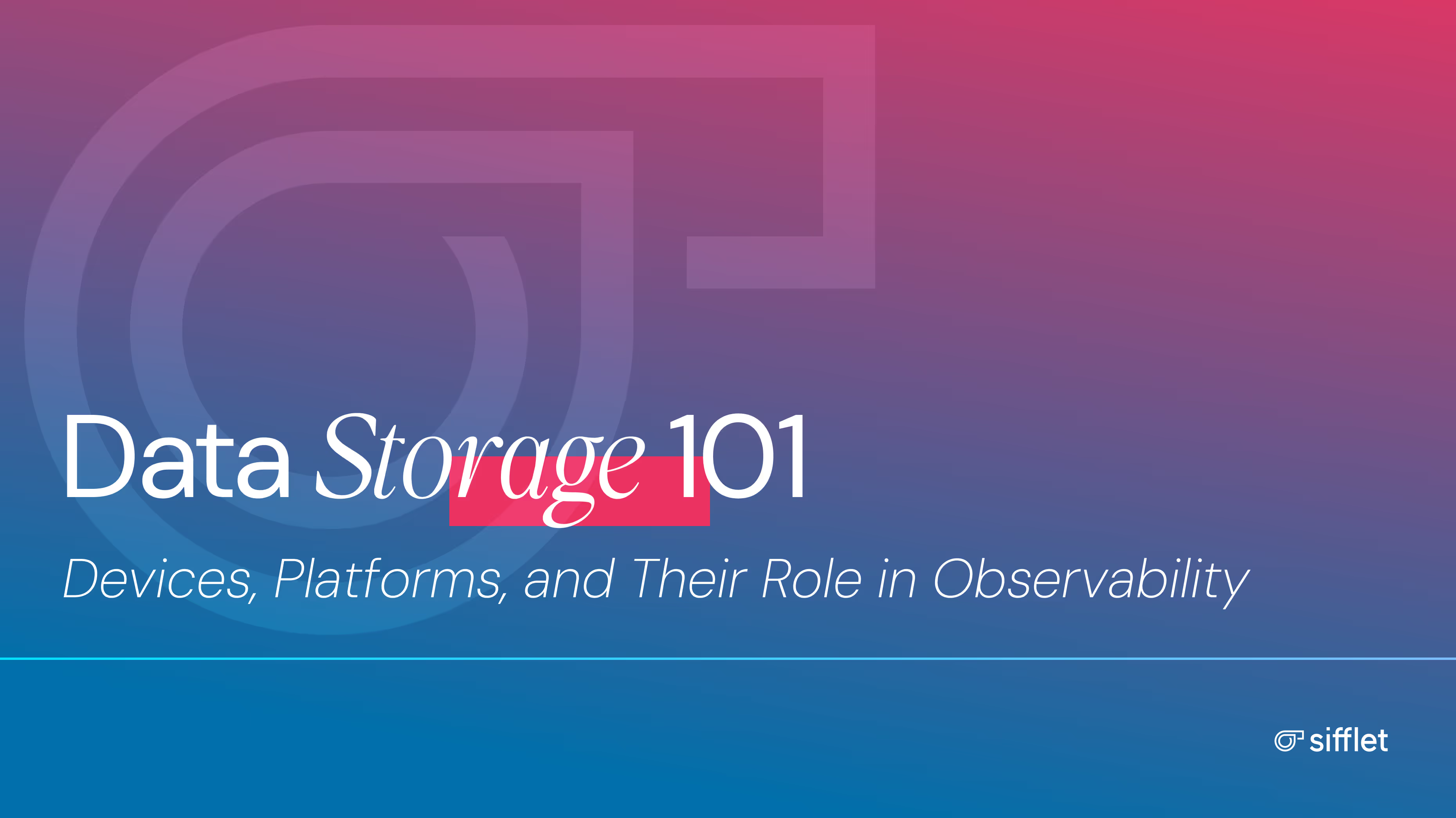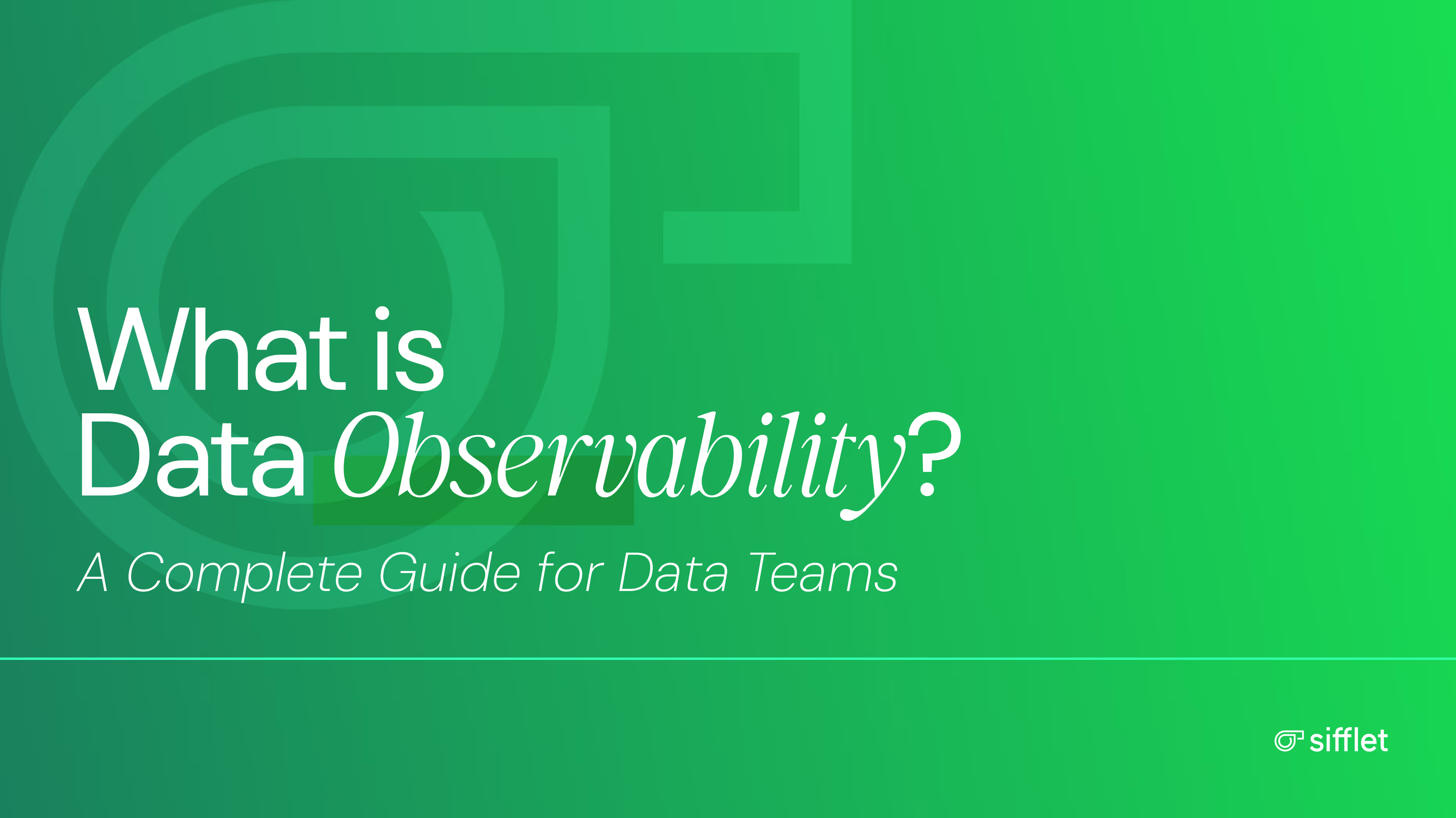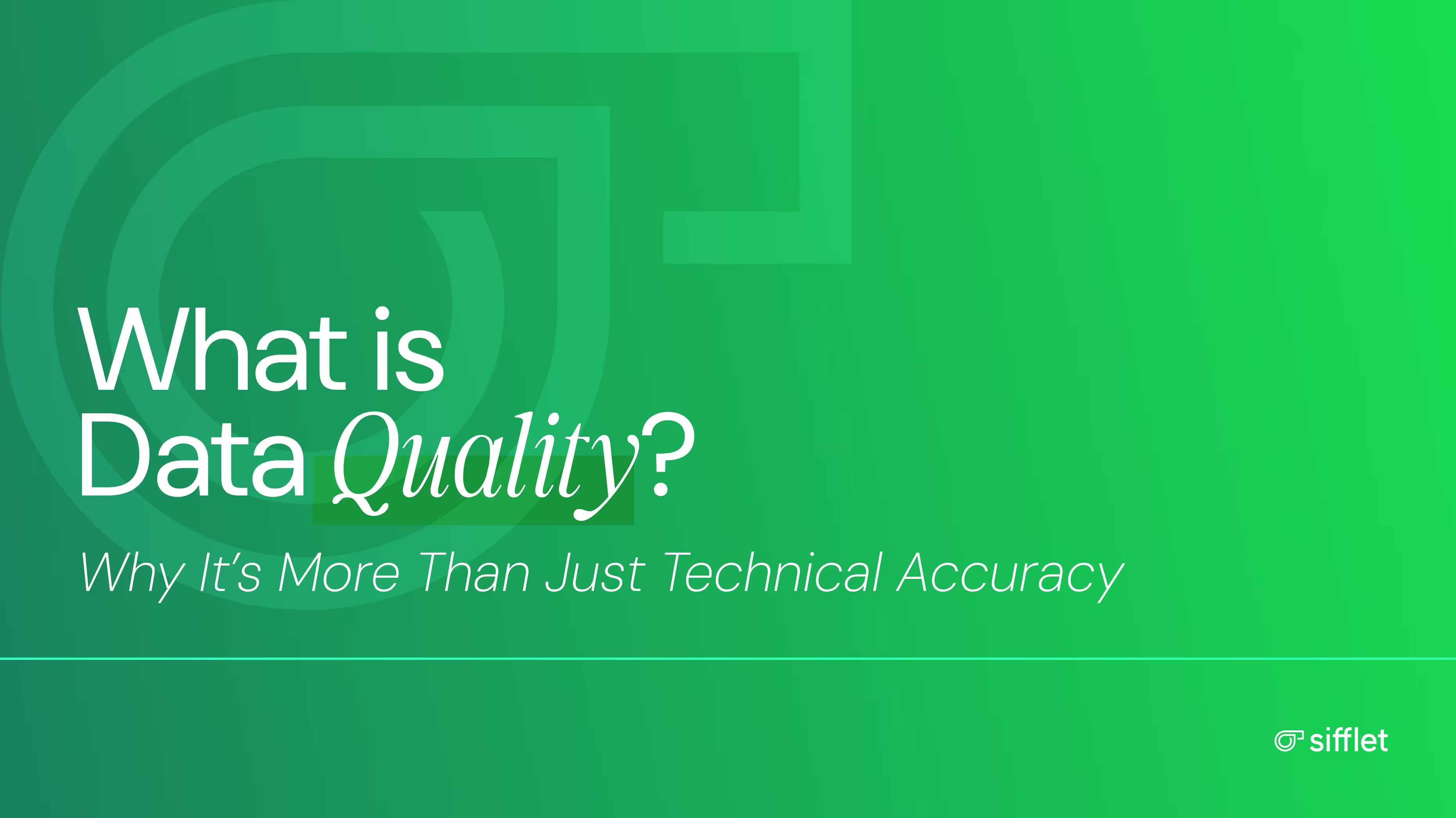Data storage is the quiet foundation beneath every decision made with data. It doesn’t shout or sparkle, but it shapes everything from how data is processed, to when it’s accessible and whether it can be trusted.
In the rush to monitor pipelines, instrument dashboards, and deploy AI, storage is often treated as someone else’s problem.
A solved layer. A box checked.
It’s not.
The truth is, you can’t monitor what you can’t access, trust what you can’t trace, or debug what you never stored correctly in the first place.
That’s why data observability must include storage to be meaningful. When observed correctly, it functions not only as infrastructure but also as context, signal, and the first link in the chain of trust.
Platforms like Sifflet understand this. Observability does more than unpack what’s downstream, it helps trace truth back to the source.
What Is Data Storage?
Data storage has come a long way from the days of physical hard drives locked in server rooms.
Data storage is the preservation of digital information in formats that allow future retrieval and analysis.
But there is a lot more to this.
The move from on-prem hardware to cloud-native, network-based storage has transformed not just where we keep data but also how we interact with it. Legacy devices like magnetic tape and spinning disks prioritized capacity and cost.
Today’s storage architectures emphasize flexibility, scalability, and seamless integration with analytics workflows.
Traditional storage systems were largely opaque and data went in, and ideally came out unchanged. Modern platforms expose rich metadata, access patterns, and performance metrics that observability tools can use to ensure integrity across the data lifecycle.
Three storage types now anchor most enterprise architectures, each playing a distinct role in the data observability chain:
- File storage uses a familiar folder-based structure to organize unstructured data like logs, configs, and system docs. It’s ideal for long-term analysis where real-time speed isn’t critical. One example is energy companies archiving decades of geological surveys.
- Block storage breaks data into fixed chunks across devices, allowing ultra-low latency access. It powers high-performance systems where milliseconds matter, like manufacturing sensors and quality control pipelines that demand real-time visibility.
- Object storage treats each file as a self-contained object with rich metadata. This metadata-first design turns storage itself into an insight source. Platforms like Amazon S3 and Google Cloud Storage use it to support everything from data lake analytics to ML training.
Why Does This Matter for Data Observability?
The relationship between storage architecture and observability is both technical and foundational to business trust.
Observability relies on three core storage characteristics that are often invisible…until they fail.
Consistency ensures that the same query yields the same result, no matter when or where it runs.
Silent corruption during writes or timing mismatches during reads can trigger false positives or even hide real issues. A utility company’s smart grid, for instance, depends on timestamp precision across thousands of sensors.
Inconsistent storage can mask grid instability or spark false alarms.
Accessibility governs whether observability tools can retrieve data when it’s needed.
Unexpected latency, access restrictions, or failures during peak loads create blind spots, particularly during outages, when visibility is most critical.
Whether teams can resolve incidents or watch helplessly often hinges on storage availability.
Structure preservation keeps the context that gives data meaning.
When storage systems alter schemas, merge fields incorrectly, or lose referential links, observability tools may continue to run, but the insights become meaningless.
Reliable observability depends on not just storing data, but preserving its semantics.
When these characteristics break down, so does trust. Data lineage falters. Alerts lose credibility. And decision-makers start second-guessing the insights they once relied on.
That’s why platforms like Sifflet go deep on storage integration, because observability is only as strong as the systems it watches over.
Where Is Data Stored?
Modern data storage is built in logical layers that abstract the complexity of underlying formats while serving specific analytical needs.
For observability teams, understanding these layers is critical, since each introduces its own reliability risks and monitoring opportunities.
1. Databases
Databases power the transactional core of business systems.
Row-oriented engines like PostgreSQL and MySQL maintain data integrity through ACID compliance, making them ideal for capturing operational events that feed observability.
In manufacturing, databases often store maintenance logs, production schedules, and quality metrics, all data that must stay consistent even under concurrent access. When a line reports a defect, the system can quickly correlate it to equipment status, operator shifts, and material batches.
For observability, databases provide predictable schemas and stable query patterns. But their rigid structure can limit flexibility when handling fast-evolving, semi-structured data.
2. Data Lakes
Data lakes flip the script: they ingest raw data, such as sensor logs or system events, without enforcing structure upfront.
This makes them indispensable for long-term observability use cases where historical context can be critical.
Energy companies, for example, use lakes to archive years of sensor data from oil rigs and wind farms.
When an anomaly arises, like unusual turbine vibrations, engineers can retrospectively analyze patterns across time that weren’t obvious in real time.
The downside? Without strong governance, lakes can devolve into swamps.
Observability platforms must sift through noisy, inconsistent data and often need enrichment layers to extract meaningful signals.
3. Data Warehouses
Data warehouses like Snowflake and BigQuery optimize data for analytics, organizing it into clean, query-ready schemas.
They transform raw inputs into structured formats that support fast, reliable business intelligence.
In manufacturing, warehouses store aggregated production data, quality KPIs, and financial metrics used by executives.
For observability, they’re ideal for dashboards that demand clean, validated metrics.
But ETL processes can introduce latency or distortions, so observability tools must account for what happens between raw ingestion and final warehouse storage.
4. Data Lakehouses
Lakehouses combine the best of lakes and warehouses, offering raw data storage alongside structured analytics in a unified platform.
Tools like Databricks let teams query unprocessed logs and curated datasets side-by-side.
This is a game changer for observability. When a system fails, teams can investigate real-time sensor streams while referencing historical trends, without toggling between environments.
Lakehouses allow fast iteration, deep visibility, and rich context all in one place. But like any hybrid model, they require careful configuration to avoid complexity creep.
How Is This Different from a Data Catalog?
This distinction trips up many organizations building observability systems: storage platforms hold your data, while data catalogs help you understand what you're holding.
A data catalog functions as the comprehensive map of your data storage landscape.
Where a warehouse physically contains your production metrics and quality measurements, the catalog maintains the metadata that explains what those metrics mean, who owns them, how they're calculated, and what business processes depend on them.
Consider this comparison:
The catalog-storage relationship becomes critical for effective observability.
When Sifflet detects an anomaly in your manufacturing quality data, the catalog information reveals which production lines are affected, which managers need notification, and what downstream processes might be compromised.
The storage system provides the data; the catalog provides the context that makes that data actionable.
Without this contextual layer, observability tools can tell you that data changed, but they can't tell you why that change matters or who should respond.
The catalog helps transform technical storage events into business-relevant insights.
Why Safe Data Storage Matters
Storage reliability is a business-critical foundation.
When storage systems fail silently or corrupt data, observability tools may miss the problem entirely.
The result? Misguided decisions, compliance violations, and massive organizational risk.
- Security
Data breaches often start with compromised storage, but the real damage begins when observability tools fail to detect abnormal access.
In the energy sector, undetected intrusions targeting infrastructure can go unnoticed if storage layers aren’t monitored.
Storage must be observable itself: who accessed what, when, and whether behavior signals a threat.
- Interoperability
Modern architectures rely on interconnected storage systems, each serving a different purpose.
If an API breaks, a schema evolves, or an integration fails, downstream observability loses context.
A manufacturer, for example, might store sensor logs in object storage, metrics in a warehouse, and quality data in a transactional database. All must remain visible to the observability layer.
- Compliance
Regulations increasingly demand not just data retention, but proof of integrity and control.
Observability tools must support lineage tracking, retention enforcement, and auditability.
Under NERC CIP rules, for instance, energy companies must continuously monitor critical system data and maintain a verifiable trail of access and activity.
At the intersection of storage and observability lies a compound trust requirement:
Organizations must trust that data is stored correctly and that they’ll be alerted when it isn’t.
That’s why platforms like Sifflet integrate deeply with storage infrastructure. Because without storage observability, data observability is incomplete.
3 Best Data Storage Tools (And Why Observability Depends on Them)
While dozens of storage platforms compete for enterprise attention, three standout as foundational to modern observability architectures.
Each serves distinct purposes in the data pipeline, and each requires specific observability approaches to ensure reliability.
1. Snowflake
AKA: the modern analytics warehouse
Snowflake has redefined what organizations expect from analytical storage, combining the structured reliability of traditional warehouses with cloud-native scalability and performance.
For observability purposes, Snowflake's architecture provides several critical advantages.
The platform's metadata-rich design gives observability tools like Sifflet unprecedented visibility into data usage patterns, query performance, and structural changes.
When a manufacturing company loads daily production data into Snowflake, Sifflet can automatically detect volume anomalies, schema drift, or data quality issues before they affect downstream dashboards or reports.
Snowflake's time-travel capabilities enable sophisticated observability scenarios where teams can investigate how data looked at specific points in time, crucial for forensic analysis of data quality incidents.
If an energy company's consumption forecasting model begins producing unusual results, engineers can use Snowflake's historical data access combined with Sifflet's lineage tracking to identify exactly when and where data changes affected model inputs.
Sifflet integration capabilities: Automated freshness monitoring, schema change detection, query pattern analysis, and data quality validation all operate natively within Snowflake's architecture, providing seamless observability without performance impact.
2. Amazon S3
AKA the universal object store
Amazon S3 has become the de facto standard for object storage, serving as the foundation layer for everything from data lakes to backup systems.
Its ubiquity makes S3 integration essential for comprehensive observability.
S3's metadata capabilities allow sophisticated monitoring of data ingestion patterns, file structure changes, and access behaviors. When manufacturing sensors stream data to S3-based data lakes, observability tools can monitor not just whether data arrives, but whether it arrives in expected formats, volumes, and schedules.
The challenge with S3-based observability lies in the platform's eventual consistency model and the variety of data formats it typically contains.
Unlike structured databases, S3 often stores semi-structured or unstructured data that requires additional processing to extract meaningful observability signals.
Sifflet integration capabilities: Ingestion pattern monitoring, schema drift detection for structured data formats, file-level metadata analysis, and integration with downstream processing pipelines for comprehensive data lineage tracking.
3. MongoDB:
The document database for modern applications
MongoDB's document-oriented approach serves the growing need for flexible, schema-evolving storage that can adapt to changing business requirements.
For observability, MongoDB presents both opportunities and challenges.
The platform's flexible schema makes it ideal to store the varied data formats that modern observability requires, everything from IoT sensor readings to user behavior events to system logs.
Energy companies often use MongoDB to store smart meter data that evolves as new sensor types are deployed or measurement requirements change.
However, MongoDB's schema flexibility can also create observability complexity.
Unlike fixed-schema systems, MongoDB collections can evolve organically, potentially breaking downstream analytics or alerting rules. Observability tools must be sophisticated enough to detect meaningful schema changes while ignoring benign variations.
Sifflet integration capabilities: Document structure monitoring, collection-level statistics tracking, query pattern analysis, and automated detection of schema evolution that might affect downstream consumers.
Observability Starts with Trustworthy Storage
The foundation of reliable data observability isn't built on dashboards, alerts, or even sophisticated AI algorithms.
It's built on storage systems that preserve data integrity, maintain accessibility, and provide the contextual metadata that transforms raw information into actionable insights.
Every observability failure can be traced back to a storage decision: data that was corrupted during writes, metadata that was lost during transfers, or access patterns that introduced subtle timing inconsistencies. The most sophisticated monitoring algorithms in the world cannot compensate for fundamentally unreliable storage infrastructure.
This is why modern observability platforms like Sifflet invest heavily in deep storage integration.
We don't just monitor your data flows, we ensure that the storage systems underlying those flows are themselves observable, reliable, and aligned with your business requirements.
Whether your data lives in Snowflake's structured analytics environment, Amazon S3's flexible object storage, or MongoDB's document collections, the same principle applies: trusted insights require trustworthy storage.
Want to make sure your cloud data storage isn't silently corrupting your data pipelines?
See how Sifflet can help you observe your storage, catalog your assets, and trust your data. 👉 Schedule a demo





















-p-500.png)
